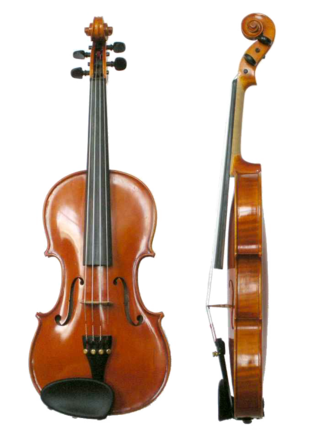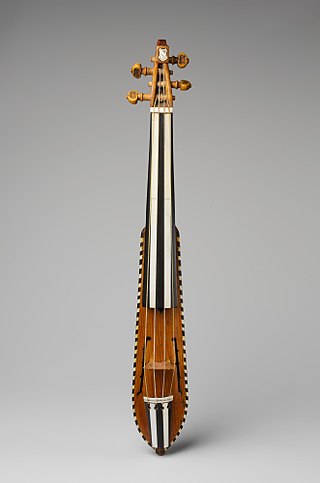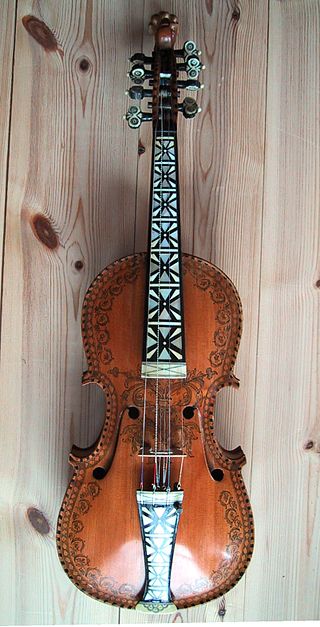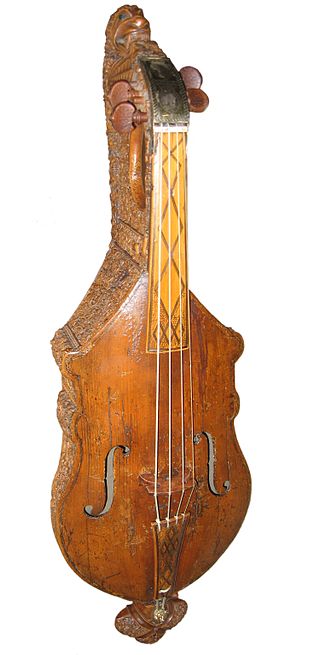
The violoncello ( VY-ə-lən-CHEL-oh, Italian pronunciation:[vjolonˈtʃɛllo]), normally simply abbreviated as cello ( CHEL-oh), is a middle pitched bowed (sometimes plucked and occasionally hit) string instrument of the violin family. Its four strings are usually tuned in perfect fifths: from low to high, C2, G2, D3 and A3. The viola's four strings are each an octave higher. Music for the cello is generally written in the bass clef, tenor clef, alto clef and treble clef used for higher-range passages.

A fiddle is a bowed string musical instrument, most often a violin. It is a colloquial term for the violin, used by players in all genres, including classical music. Although in many cases violins and fiddles are essentially synonymous, the style of the music played may determine specific construction differences between fiddles and classical violins. For example, fiddles may optionally be set up with a bridge with a flatter arch to reduce the range of bow-arm motion needed for techniques such as the double shuffle, a form of bariolage involving rapid alternation between pairs of adjacent strings. To produce a "brighter" tone than the deep tones of gut or synthetic core strings, fiddlers often use steel strings. The fiddle is part of many traditional (folk) styles, which are typically aural traditions—taught "by ear" rather than via written music.

The violin, sometimes referred as a fiddle, is a wooden chordophone, and is the smallest, and thus highest-pitched instrument (soprano) in regular use in the violin family. Smaller violin-type instruments exist, including the violino piccolo and the pochette, but these are virtually unused. Most violins have a hollow wooden body, and commonly have four strings, usually tuned in perfect fifths with notes G3, D4, A4, E5, and are most commonly played by drawing a bow across the strings. The violin can also be played by plucking the strings with the fingers (pizzicato) and, in specialized cases, by striking the strings with the wooden side of the bow.

The viola da gamba, or informally gamba, is any one of a family of bowed, fretted, and stringed instruments with hollow wooden bodies and pegboxes where the tension on the strings can be increased or decreased to adjust the pitch of each of the strings. Although treble, tenor and bass were most commonly used, viols came in different sizes, including pardessus, treble, alto, small tenor, tenor, bass and contrabass. Separating these from other bowed string instruments such as the viola da braccio was the instruments' orientation; members of the older viol family were played with the neck oriented upwards, the rounded bottom downwards to settle on the lap or between the knees.

Handcuffs are restraint devices designed to secure an individual's wrists in proximity to each other. They comprise two parts, linked together by a chain, a hinge, or rigid bar. Each cuff has a rotating arm which engages with a ratchet that prevents it from being opened once closed around a person's wrist. Without a key, handcuffs cannot be removed without specialist knowledge, and a handcuffed person cannot move their wrists more than a few centimetres or inches apart, making many tasks difficult or impossible.

A hinge is a mechanical bearing that connects two solid objects, typically allowing only a limited angle of rotation between them. Two objects connected by an ideal hinge rotate relative to each other about a fixed axis of rotation, with all other translations or rotations prevented; thus a hinge has one degree of freedom. Hinges may be made of flexible material or moving components. In biology, many joints function as hinges, such as the elbow joint.

The pillory is a device made of a wooden or metal framework erected on a post, with holes for securing the head and hands, used during the medieval and renaissance periods for punishment by public humiliation and often further physical abuse. The pillory is related to the stocks.

Stocks are feet restraining devices that were used as a form of corporal punishment and public humiliation. The use of stocks is seen as early as Ancient Greece, where they are described as being in use in Solon's law code. The law describing its use is cited by the orator Lysias: "'He shall have his or her foot confined in the stocks for five days, if the court shall make such addition to the sentence.' The 'stocks' there mentioned, Theomnestus, are what we now call 'confinement in the wood'".

The pochette is a small stringed instrument of the bowed variety. It is a small violin-like instrument designed to fit in a pocket, hence the name "pochette".

A Hardanger fiddle is a traditional stringed instrument considered to be the national instrument of Norway. In modern designs, this type of fiddle is very similar to the violin, though with eight or nine strings and thinner wood. The earliest known example of the hardingfele is from 1651, made by Ole Jonsen Jaastad in Hardanger, Norway. Originally, the instrument had a rounder, narrower body. Around the year 1850, the modern layout with a body much like the violin became the norm.
Professional wrestling holds include a number of set moves and pins used by performers to immobilize their opponents or lead to a submission. This article covers the various pins, stretches and transition holds used in the ring. Some wrestlers use these holds as their finishing maneuvers, often nicknaming them to reflect their character or persona. Moves are listed under general categories whenever possible.

The bascinet – also bassinet, basinet, or bazineto – was a Medieval European open-faced combat helmet. It evolved from a type of iron or steel skullcap, but had a more pointed apex to the skull, and it extended downwards at the rear and sides to afford protection for the neck. A mail curtain was usually attached to the lower edge of the helmet to protect the throat, neck and shoulders. A visor was often employed from c. 1330 to protect the exposed face. Early in the fifteenth century, the camail began to be replaced by a plate metal gorget, giving rise to the so-called "great bascinet".

The armet is a type of combat helmet which was developed in the 15th century. It was extensively used in Italy, France, England, the Low Countries and Spain. It was distinguished by being the first helmet of its era to completely enclose the head while being compact and light enough to move with the wearer. Its use was essentially restricted to the fully armoured man-at-arms.

A Baroque violin is a violin set up in the manner of the baroque period of music. The term includes original instruments which have survived unmodified since the Baroque period, as well as later instruments adjusted to the baroque setup, and modern replicas. Baroque violins have become relatively common in recent decades thanks to historically informed performance, with violinists returning to older models of instrument to achieve an authentic sound.
The musical traditions of Central Asia mirror the immense diversity found in the cultures and populations residing in the region. Principal instrument types are two- or three-stringed lutes, the necks either fretted or fretless; fiddles made of horsehair; flutes, mostly sige at both ends and either end-blown or side-blown; and jew harps, mostly metal. Percussion instruments include frame drums, Tam origin of the bowed string Use of the bowed string is thought to originate with nomads who mainly used the snake-skin, covered horsetail-bowed lute. In Mongolia instruments like the morin khuur or horse-head fiddle survive today.

The citole was a string musical instrument, closely associated with the medieval fiddles and commonly used from 1200–1350. It was known by other names in various languages: cedra, cetera, cetola, cetula, cistola, citola, citula, citera, chytara, cistole, cithar, cuitole, cythera, cythol, cytiole, cytolys, gytolle, sitole, sytholle, sytole, and zitol. Like the modern guitar, it was manipulated at the neck to get different notes, and picked or strummed with a plectrum. Although it was largely out of use by the late 14th century, the Italians "re-introduced it in modified form" in the 16th century as the cetra, and it may have influenced the development of the guitar as well. It was also a pioneering instrument in England, introducing the populace to necked, plucked instruments, giving people the concepts needed to quickly switch to the newly arriving lutes and gitterns. Two possible descendant instruments are the Portuguese guitar and the Corsican Cetera, both types of cittern.

A violin consists of a body or corpus, a neck, a finger board, a bridge, a soundpost, four strings, and various fittings. The fittings are the tuning pegs, tailpiece and tailgut, endpin, possibly one or more fine tuners on the tailpiece, and in the modern style of playing, usually a chinrest, either attached with the cup directly over the tailpiece or to the left of it. There are many variations of chinrests: center-mount types such as Flesch or Guarneri, clamped to the body on both sides of the tailpiece, and side-mount types clamped to the lower bout to the left of the tailpiece.

The cythara is a wide group of stringed instruments of medieval and Renaissance Europe, including not only the lyre and harp but also necked, string instruments. In fact, unless a medieval document gives an indication that it meant a necked instrument, then it likely was referring to a lyre. It was also spelled cithara or kithara and was Latin for the Greek lyre. However, lacking names for some stringed instruments from the medieval period, these have been referred to as fiddles and citharas/cytharas, both by medieval people and by modern researchers. The instruments are important as being ancestors to or influential in the development of a wide variety of European instruments, including fiddles, vielles, violas, citoles and guitars. Although not proven to be completely separate from the line of lute-family instruments that dominated Europe, arguments have been made that they represent a European-based tradition of instrument building, which was for a time separate from the lute-family instruments.

The classicalkemenche, Armudî kemençe or Politiki lyra is a pear-shaped bowed instrument that derived from the medieval Greek Byzantine lyre.

Double-decker or Dubbelplansfiol is a recent and colloquial name of the dominant variant of preserved Swedish violins with sympathetic strings, what they were called when they originated in the 18th century is not known. The Swedish collector of musical instruments Daniel Fryklund writes in 1921 that "In Sweden, the author has found several violini d'amore of a peculiar type with 4 strings and 8 resonance strings, of which the later are attached to small pegs, which are placed behind the larger screws for the playing strings in a pegbox which is extended backwards and such an arrangement of the pegs is not observed by the author on any other violin". Thus, Fryklund suggests it is a specific instrument type typical for Sweden but since he only has observed five instruments he does not conclude it and calls it with the more unspecific name violino d'amore. Today more specimens have been found and out of 27 preserved Swedish violins with sympathetic strings in total, 23 are Double-deckers. Also three of the four preserved instruments that are not Double-deckers are built during the 20th century, while the vast majority of the Double-deckers with a known origin are built during the 18th century which indicates that the Double-deckers are both earlier and dominant




















